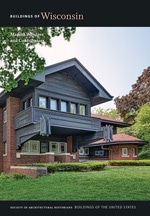
Gothic Revival barns became popular for a time after World War I, but few are as extraordinary as this barn. The Agricultural Experiment Station at the University of Wisconsin began promoting Gothic-styled barns in the early 1920s because their pointed, nearly parabolic roofs offered even greater storage capacity than gambrel-roofed barns. The haymow offered an unobstructed space because each set of roof ribs was self-supporting. Lumberyards offered precut, laminated rafters, making the complicated roof system available to farmers. These roofs proved particularly popular for Wisconsin dairy barns. Characterized by long dimensions, a window at each stall, and an attached sanitary milk room, these barns promoted livestock health and sanitary dairy operations. In building his barn, Scott created an exceptionally handsome structure with walls of colorful native fieldstone, laid in a random fashion with ample mortar. Details include slightly arched lintels made of rectangular stones and wedge-shaped keystones and quoins at the corners. Overarching these walls is the dramatic roof. Its beak-like hanging gable sheltered a beam that supported the rigging used to hoist hay into the mow.














